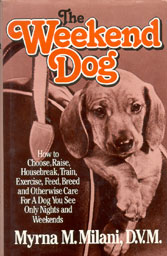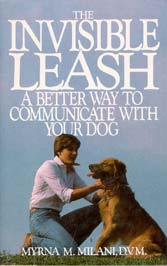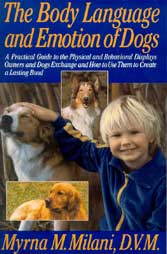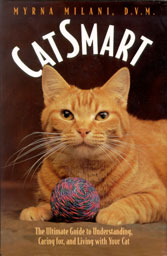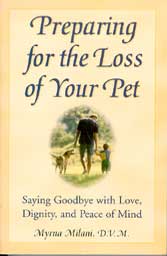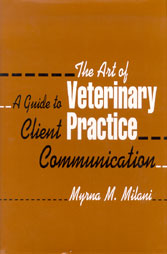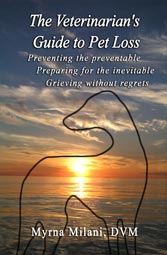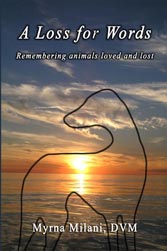Over the years I’ve written seven books for the general public on various aspects of canine and feline behavior and the bond, and one bond- and behavior-based veterinary text. I’ve included some personal remarks about each book and its content.
- The Weekend Dog
- The Invisible Leash
- The Body Language and Emotion of Dogs
- The Body Language and Emotion of Cats
- DogSmart
- CatSmart
- Preparing for the Loss of Your Pet
- Speechless in Eden
- The Art of Veterinary Practice: A Guide to Client Communication
- The Veterinarian’s Guide to Pet Loss
- A Loss for Words: Remembrances of animals loved and lost
The Weekend Dog
The Weekend Dog was the first book I wrote, way back in 1984. When I graduated from veterinary school in the early 70s, the mass migration of women into the work force had just begun and it quickly became apparent that neither my veterinary education nor any of the training texts I’d read allowed for this phenomenon. Rather they were-and in many cases still are-based on the assumption that someone, usually mom or some other woman, spends most of her time at home with the dog. In this book I explored the canine and bond problems that result when working owners try to implement programs based on a lifestyle different from their own. Difficult as it is to believe now, I banged this book out on an ancient typewriter, then had a professional typist prepare the final copy for the publisher. My, how times have changed!
A short time after I wrote that book, the attack of the Killer MBAs hit publishing and I lost track of how many buy-outs and mergers the original publisher went through before the book disappeared completely. Although a few copies might still exist in library collections somewhere, it remains a favorite of mine because it enabled me to share with others many of the things my clients had shared with me. It also helped me lay the groundwork for the comprehensive approach to animals as combined body-mind units who participate in co-created body-mind relationships with their owners that I expanded in my later work.
Although I sometimes feel sad that the book is no longer available, I also realize that both the science of the bond and behavior have advanced a great deal since then and so have I. Still, I sometimes yearn for the days when it all seemed so simple.
The Invisible Leash
The Invisible Leash (1985) resulted from my awareness that most people relate to dogs as if dogs perceived the world the same way we do. In this book, I discussed each of the canine senses-vision, hearing, smell, touch, and taste-and proposed a method of analyzing problem canine behavior based on the answers to those familiar journalistic questions: who, what, when, where, and why. At that time, and still to this day to some extent, not that many people working in the field expressed much interest in why problem behaviors occurred, and particularly not when the relationship with the owner played a critical role in that why.
Of all my books for the general public, this one probably received the least exposure. This occurred not only because the publisher went through the mergers and buy-outs typical for that period, but also because the editor who originally acquired the book somehow disappeared during the shuffle. Since then, I’ve come to accept the Disappearing Editor as a routine publishing event. However, back then it came as quite a shock to a novice writer. The book then became what’s known as orphan, a name that elicits images of some Depression-era ward of the state who receives only that minimal amount of attention. Although accurate relative to the book’s life in this country, the Dutch version has enjoyed a long life in the Netherlands where it is still available.
This book also signaled the first of my failed attempts to write a “quick-and-dirty” book. I really did try, but the more I learned about domestic animal behavior and the human-animal bond, the more impossible this became. The more clients I saw, the more variables I realized I needed to take into account to help a particular owner and pet through a particular problem at that particular time in their lives.
Further conspiring to lengthen my books, The Weekend Dog had introduced me to the value of the anecdote as a teaching device and I further developed this concept with each successive book. Because I’m an integrated rather than linear thinker myself (Are you surprised?), I find texts that present only facts or methods boring as well as sometimes difficult to understand. On the other hand, when an author demonstrates how certain elements manifest in a particular setting, I find it much easier to both comprehend and remember them because I can relate the material to something specific.
Initially I worried that providing a specific anecdote would lead to a more restricted view. For example, if I described what happened when Mary Brown’s 4-year-old male neutered golden snapped at her, would readers think that all the concepts I described only applied to women and dogs who matched that description? However, that didn’t prove to be the case at all and, in fact, just the opposite often held true: The anecdote served as a template which enabled readers to apply the concepts to a wide range of circumstances. To say that this pleased me is putting it mildly!
Unfortunately, presenting material in both linear and integrated (or logically and analogically, if you prefer) forms takes more space. Although readers whose analogical orientation is often ignored in nonfiction appreciate this approach, linear thinkers find it adds unnecessary length to the book. However, having experienced eight years of a highly linear scientific education which essentially required that I re-teach myself everything in a nonlinear form that made sense to me following graduation, upsetting the linear folks no longer bothers me like it used to. Or at least it doesn’t bother me enough to provide what I consider a less comprehensive discussion of an issue just to please them.
The Body Language and Emotion of Dogs
The Body Language and Emotions of Dogs (1986) introduced me to one of the best editors I ever worked with, Eunice Riedel. Eunice was an anthropologist by training and recognized the power of the human-animal bond at a time when many considered it a warm fuzzy curiosity. With her guidance and approval, I began putting more of myself into my books and exploring the range of the human-animal interactions.
When this book was written, linking animals and emotion practically guaranteed that the scientific community would slap their most derisive adjective, “anthropomorphic,” on you and you would be grouped with those whose poodles wore silk pajamas or whose cats ate out of Waterford crystal bowls. Since then, the awareness that animals possess the same receptors for the same neurochemicals associated with certain emotions in the same areas of the brain that humans do has taken some of the wind out of the sails of those who take a mechanistic view of animal behavior. However back then I knew that, if I wanted to introduce the concept of emotions into human-animal interactions, I would need to do it very carefully lest I antagonize the powers that be. As an independent scholar rather than one affiliated with any academic institution or particular group I was, and still remain to some extent, a more solitary intellectual cat in a more social dog-dominated world. On the other hand, my independence gave me the freedom to explore these subjects in a manner I could not have achieved otherwise.
To that end, I took an approach that I believe remains valid. Whether animals-and in this book, specifically dogs-experience emotions or experience them the same way we do doesn’t really matter. What matters is what emotion we think animals convey via their behaviors because this will affect their behavior and that, in turn, will affect our relationship with them for good or ill. Consequently, recognizing what certain behaviors communicate in canine terms so we don’t inadvertently attribute the wrong emotion/meaning to these confers a definite interspecies communication advantage. By exploring the emotions-such as guilt, love, independence, sorrow, jealousy-that we commonly attribute to canine displays as well as what these displays also mean in canine “language,” I hoped to sensitize readers to the value of seeing the world from the dog’s perspective as well as their own.
Thanks to the efforts of a good friend with a scanner, I’ve included an excerpt from this book and will add those from the others (The Weekend Dog, The Invisible Leash, The Body Language and Emotion of Cats) that I wrote pre-computer as time allows. Although some spacing variations may occur in the scanned versions, the content accurately reflects that of the original books.
The Body Language and Emotion of Cats
The Body Language and Emotion of Cats (1987) naturally followed The Body Language and Emotion of Dogs. What sticks out most clearly about the publication of this book was Eunice’s death within days of receiving the manuscript. Trite though it may sound, she remained so gracious throughout our association that I never even realized she was ill. As editors go, she was one in a million. Where others said, “Give me quick-and-dirty,” Eunice said, “Explore. Stretch the limits.”
Doing the research for my first book exploring feline behavior and the human-feline bond immediately brought home a truism I’d learned in veterinary school about canine and feline physiology: Cats are not little dogs. Because I realized that few people recognized, let alone understood, the basic feline behavioral repertoire capable of generating a sometimes almost schizophrenic spectrum of human emotion, this book focused on those behaviors as they related to emotions, rather than vice versa as in the dog book.
When I researched and wrote this book, I also realized that I couldn’t write effectively about contemporary human-feline relationships without exploring the history of human-feline interactions. Unlike the human-canine relationship which has remained relatively stable for thousands and thousands of years, wild fluctuations from deification to vilification have marked the cat’s very brief association with people, with these opposing human orientations sometimes occurring simultaneously. As I explored the cat’s solitary, territorial, predatory, maternal, and sexual behaviors, I realized why the human-feline bond elicited such strong emotions: In many ways our dogs serve as a four-legged, fur-covered mirror of our public selves, but our cats mirror our most intimate and private selves, something not everyone feels comfortable seeing!
Researching this book also signaled the beginning of my on-going fascination with the process of domestication. Because cats rank as our most recently domesticated or, more correctly, our only undomesticated “domesticated species,” observing the changes in feline health and behavior can provide valuable clues regarding this process. At that point in my career, though, I simply noted that those breeds which had experienced the most human manipulation-such as the Siamese, Persians, and their derivatives-sometimes displayed different behaviors and relationships with their owners than the more cat-like domestic shorthairs.
This book also served as the foundation of seven years of public relations work during which I spoke to thousands of owners, veterinarians, and breeders. Although I like to think that I broadened their knowledge and understanding of feline and canine behavior and the human-domestic animal bond, they also provided me with an incredible wealth of personal insights and observations for which I will always remain grateful.
Although there are some things I would change if I were writing the body language books today, the fact that these didn’t come out in trade paperback form until the early 90s, and that both have been used, and are still being used, here and in Europe to sensitize trainers and others to the more intimate aspects of human-animal interaction attests to the timelessness of the concepts explored. This brings me great joy.
DogSmart
DogSmart (1997) ended a nonfiction literary dry spell. During that time, I’d begun writing fiction and also wrote a veterinary text (more on these later) and although numerous nonfiction proposals made the rounds, none elicited any interest from publishers. This book, and its companion, CatSmart, resulted from years of friendship with two trainer/behaviorists, Bill Campbell and Job Evans. Time and time again during our decades of friendship, one or the other of us would groan, “Anyone who’s in this business needs to have their head examined!” The more complex human-animal relationships and owner lifestyles became, the more common the refrain. That got me thinking about a book which would help owners explore their pets’ behaviors and their responses to these themselves, a sort of self-psycho-analysis for pet owners. By doing this, readers would develop an understanding of their and their animal’s unique needs. Armed with this knowledge, they could then select those training, feeding, exercise, and medical approaches that best fulfilled these requirements.
Given the advent of the Internet which gave me access to a wonderland of scientific studies and the plethora of training methods and devices, feeding, exercise, and medical options available to contemporary dog owners, this definitely was not a quick-and-dirty book. To say that it didn’t please those who wanted such a book is an understatement! DogSmart asks owners to delve into their most intimate beliefs and relationships with their dogs and initiate programs that best meet their needs. People who prefer dominance-based reactive approaches don’t like that: They want some guru to say, “You do this.” Unfortunately, such an approach negates the development of the very leadership skills necessary to resolve many canine behavioral problems. Nonetheless, the dominance-based theory of training and the wolf studies from which it evolved continue to permeate the literature. However, as more and more studies reveal the unique features of domestic canines and their relationships with humans, hopefully this trend will wane.
CatSmart
Just as DogSmart enabled me to explore more recent studies of canine behavior and the human-canine bond, CatSmart (1998) enabled me to do the same in the feline realm. And even as studies of dogs suggest an ever longer history of domestication, observations of felines suggest this species still teeters precariously on the very thin line separating wild and domestic. In this book I examine what we now know about feline behavior, the effects of breeding, how cats relate to their space, and the human-feline bond. A friend has dubbed its chapter on various problematic human-feline relationships as a tour through “Mr. Roger’s psycho human-feline neighborhood,” which, while not an exactly accurate description, isn’t that far off either! Because then and now, not using the litter box ranked as the most commonly mentioned feline behavioral problem, I also devoted an entire chapter of this book to its many causes. Even so, so many medical, behavioral, and bond factors may underlie feline elimination problems that it would take an entire book to delve into them completely.
CatSmart also asks owners to create a personalized data base for themselves and their pets using the exercises provided throughout each chapter. They can then use that information to sort through the wide range of feeding, exercise, and medical programs (and all their assorted paraphernalia!) discussed in the second half of the book. Although I realized that naming specific products and providing prices could date the books, I also wanted owners to know what financial as well as physical, time, and emotional requirements these various options entailed. Because a primary dictum of behavior maintains that inconsistency will make a problem worse doing nothing at all, and because the same holds true for physical problems, I want owners to select programs they know they can successfully implement from the get-go. Like DogSmart, CatSmart also concludes with directions for at-home physical, behavioral, and bond check-up owners can perform regularly to detect and prevent problems.
Once again, those who were really into cat behavior and the human-feline relationship loved the book, but those looking for a quick fix hated it.
Preparing for the Loss of Your Pet
Preparing for the Loss of Your Pet: Saying Good-bye With Love, Dignity, and Peace of Mind (1998) undoubtedly can claim the most misleading title of any book I’ve written. My working title, No Regrets: Holistic Preparation for the Loss of Your Pet, No Matter How and When it Happens, more correctly reflects its contents. This isn’t yet another one of those books for pet owners trying to come to terms with the loss of a pet. Rather it’s a book to read when all goes perfectly well with our pets and thoughts of illness, injury, death, or disappearance seem impossible. Why impose such a dark cloud on such a sunny landscape? Because I know from years of working with owners in crisis that fear often replaces objectivity at such times and many owners make decisions they later regret.
Because fear of the unknown invariably ranks as the greatest fear, this book explores what happens when an animal dies, is euthanized, becomes lost, or is given up. At the same time, though, it provides ways for owners to avoid those aspects of these processes that they find personally upsetting. For example, owners and veterinarians may possess different philosophies regarding euthanasia: This is not something you want to discover when you pet is dying. Many pets become lost and remain so because owners neglect to take a few simple precautions to ensure this won’t happen or to help guarantee that they’ll find their pets quickly if it does. Countless animals wind up abandoned or given up because of behavioral problems that could be avoided or resolved if owners considered how those problems arise in the first place.
Once readers become comfortable with thinking the unthinkable, the book then explores the different ways the loss of a pet may affect us. Had I written this book ten years ago, I would have spoken of the different ways loss affects men and women. However, thanks to input from gay clients and reading the latest on the highly complex nature of human and animal sexuality, I opted to discuss how the loss affects those with more nurturing and sensual versus more reserved orientations. I will never forget the day my totally non-animal-oriented editor called and sputtered, “We cannot publish a book that condones people having sex with animals!” She simply could not deal with the fact that for many people, the scent, look, and feel of the animal plays a critical role in the relationship and one that some owners sorely miss when pet loss occurs. Even when I tried to explain, she found the notion totally disgusting and wanted me to delete the chapter entirely. I refused, which goes to show how passionately I believed that people needed validation for these perfectly normal feelings because I’m a very compliant person by nature. Parts of it were cut and my replacement of the word “sensual” with “sensory” was later changed to the highly misleading “physical” and totally incomprehensible “human-animal bond” without my permission. Never in my wildest dreams when I wrote this chapter did I suspect that it would create such a storm!
Chapters on the effects of pet loss on children and those with special needs round out the discussion which concludes with a section of writing living wills/advanced directives for pets. Although a non-animal person might consider living wills the epitome of owner whackiness, it serves two valuable purposes. One, it provides a structure whereby owners can explore any limits that might come into play when their pets become terminally ill or injured. Not only does this keep them from making choices they later regret, exploring these limits under the best of circumstances enables them to consider options that might escape them in a moment of crisis. Two, several people have told me that working through these issues for their pets caused them to get over their fears about working through these end-of-life decisions for themselves. Although that certainly wasn’t my goal, it further demonstrates the range and magnitude of the gifts our pets bestow upon us.
Speechless in Eden
Aside from its first chapter, Speechless in Eden exists only as a proposal currently making the rounds through various publishers. Its subtitle, The Science, Myth, and Magic of Human-Domestic Animal Communication pretty much sums up its goal. Essentially, I propose that humans and animals ability to affect each other’s physiology creates a nonverbal “language” that’s far more precise than any spoken word. Although interspecies communication occurs so frequently in wild animals as to rank as the norm rather than the exception, I limit myself to exploring that which occurs between humans and other domestic animals because the peculiar physiological and behavioral changes associated with domestication. I became interested in this after reading about the long-term Russian studies of silver foxes which provided me with one of those fantastic, knock-your-socks-off Aha! moments that caused me to look at the human-companion animal bond in a whole new light.
Additionally, I wanted to explore human-domestic animal communication because it so often has suffered from trivialization among the general public or dismissal by the scientific community. Ironically, in both realms the image of what comprises acceptable animal communication remains the same: Animals must talk (preferably English), use sign language, computers, or some other human form of communication to prove they possess the mental wherewithal to communicate with us. Not surprisingly, our arrogant insistence that animals learn our language has resulted in a bizarre paradox: Although the average pet dog can understand more than a hundred human words, the average owner understands few, if any, dog “words.” Considering we’re the ones with the supposedly greater intelligence, that’s pretty ironic!
In addition to exploring animal thinking, emotions, sensory and extra-sensory potential, and human and animal social orientation as these affect interspecies communication, the book would also explore the latest on human leadership relative to social animals. Of all the concepts that can prevent or resolve problem canine behavior, none looms so great as leadership. However, trying to help those bombarded by the misconception that dominance equals leadership which permeates training, athletics, politics, and business is not an easy task. Fortunately, increased studies of human-canine interactions as well as those between wolf adults and pups enable us to give the “alpha shtick” a long-overdue burial, and free ourselves to delve into the subtle, but critical qualities that make leadership so much superior.
The Art of Veterinary Practice : A Guide to Client Communication
Writing The Art of Veterinary Practice in 1995 fulfilled a promise I made to myself a year after my graduation in 1972. I wanted to become a veterinarian because the way an animal’s behavior and its relationship with the owner affected its health fascinated me, as did the relationship between the animal, the owner, and the veterinarian in preserving animal physical and behavioral health. This view seemed totally natural to me because my German grandmother felt the same way about human health. Although she worked diligently to become thoroughly Americanized, she could never accept the problem- rather than person-oriented approach of American medicine. Because the veterinarian who cared for my childhood pet in the 50s and 60s reflected my grandmother’s views, it never dawned on me that my veterinary education wouldn’t do likewise. Boy, was I ever wrong! What I had failed to take into account was that someone had decided that it would elevate the status of veterinarians if veterinary education patterned itself after human medicine. Why they felt, and some still feel, the need to do this remains a mystery to me.
Disenchantment and fear that I’d made a dreadful mistake plagued me throughout my veterinary education. I’d worked in a human hospital and found it linear to the point of uncaring and inhumane; that’s why I wanted to be veterinarian rather than a physician. Bummer. Fortunately, throughout my education I encountered a few rare and special faculty members who did recognize these connections even if these played little role in the curriculum. To this day, I remember their informal comments as the most meaningful part of my education and will always cherish their willingness to share these.
After one week in private practice, I realized that failure to take into account the animal’s behavior, its relationship with the owner, and both of their relationships with me did indeed play a most critical role in the treatment process, which explains the subtitle to the book: A Guide to Client Communication. Regardless of the fact that veterinary education devotes itself to teaching students to speak the language of science and technology, owners speak the language of the behavior and the bond. Unless, veterinarians recognize this, they will not be telling be telling clients what they want and need to know. Because of this, I vowed that I would one day write a book that addressed these and all the other “soft” topics that cause veterinarians and their clients the most grief and for which the science- and technology-driven curriculum still can’t find time. To that end, the book covers topics such as problematic owner-animal relationships, how love and guilt affect the treatment process, animal rights, alternative or complementary medicine, dealing with terminal illness and death, euthanasia, and burn-out.
One interesting historical note: This book almost didn’t get published because it had to go through a final peer review process. Although the first reports came in almost immediately and were very positive, we waited and waited for the last one. When it finally arrived, it was quite negative and said the book should not be published because it didn’t address topics A, B, C, and D which this person believed were crucial. Normally that would have killed the book right there, except for the fact that the book did address those topics, and sometimes even devoted whole sections to them. Naturally, I was devastated and questioned the mental competency of the individual involved. However, my wonderful editor told me she had seen this happen before and not to worry; she would send the book out to someone else. Apparently, there are those who spend so much time evaluating issues strictly from their own linear perspective that their minds simply can’t comprehend these when presented from any other point of view. Because I addressed issues A, B, C, and D as they affected the animal and/or the owner rather than the veterinarian, that particular reviewer’s mind didn’t recognize the material at all. Admittedly this sounds bizarre, but once I realized what had happen, I easily accepted it because difference in human and animal perceptions often lead individuals to perceive quite different realities, too. However, I doubt I would have felt so charitable had all the reviewers lacked this greater vision! Also, since the book’s publication, veterinary technicians, those in other animal care professions, and those who just have an interest in the human-animal bond have told me how much they enjoyed this intimate view of veterinary
The Veterinarian’s Guide to Pet Loss
The Veterinarian’s Guide to Pet Loss is an updated look at material I first wrote about in the late nineties. The book’s subtitle sums up its goal: Preventing the preventable, preparing for the inevitable, and grieving without regret. Although the book covers much of the same ground as its predecessor, our society has changed a great deal since those optimistic days more than two decades ago. Since 9/11 we have become a more frightened and paranoid society as well as a lonelier one. Because of that, our relationships with our companion animals also have changed. We now need them more than ever.
Back in the nineties the idea of a pet loss book that considered losses from causes other than death just didn’t compute in the publishing and public psyche. What little marketing and promotion that was done then positioned the book with those dealing with loss strictly by death, and then almost inevitably after-the-fact. Even the title and subtitle of the book were changed so it better fit into that established marketing niche.
But the value of prevention over after-the-fact treatment forms the core of my professional philosophy regarding animal health, behavior, and the human-animal bond. The more we do when our animals are alive to ensure we don’t lose them to avoidable health, behavioral, and/or bond problems, the fewer regrets we’ll experience when they die. When we prevent the preventable, we then can grieve for the loss of a companion with whom we shared a fulfilling life instead of being tortured by feelings of guilt and regret for things we should have done but didn’t.
The Veterinarian’s Guide to Pet Loss also enabled me to include additional information that was considered too suggestive for the average companion animal owner to handle in the late nineties. Unlike my novel, Beastly Business which truly does deal with an aspect of the human-companion animal bond some might find troubling, the omitted material in the original pet loss book simply discussed the sensory loss that accompanies the loss of a beloved animal companion. I’d included it because conversations with clients and friends convinced me that the belief that these quite normal experiences were somehow wrong unnecessarily hampered the grieving and healing process. Alas my then-editor was among those who believed there truly was something wrong with people who missed the touch and feel of their animals. Maybe that person was right, but I like to give my readers more credit than that.
A Loss for Words: Remembrances of animals loved and lost
A Loss for Words: Remembrances of animals loved and lost is a collection of essays and stories I wrote about pet loss under a variety of circumstances, some true, some fiction. I put this together at the request of a friend during a discussion about the grieving and healing process. While I certainly hope readers find comfort in the collection, I also hope it inspires them to write such essays about their own animals lost under any circumstances. From personal experience I know how helpful this can be. Including remembrances in a real-life or virtual memorial also gives us the opportunity to put our thoughts and emotions into words. It enables us to put order into the emotional chaos that may seem overwhelming. It enables us to express feelings we might otherwise never express.
